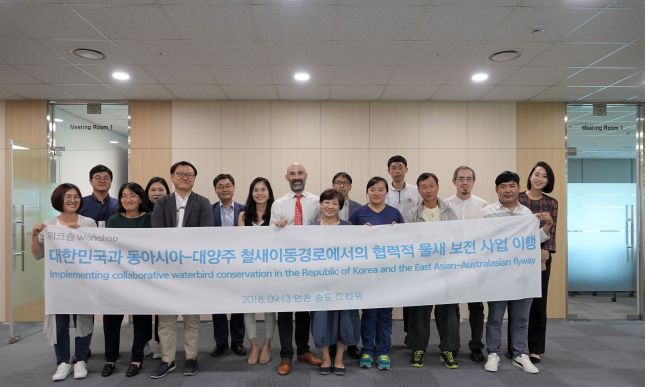
Group Photo (c)Minshil Lee/EAAFP
On 13 September 2018, a workshop titled “Implementing collaborative waterbird conservation in the Republic of Korea and the East Asian-Australasian Flyway (EAAF)” was held at G-tower, Songdo, RO Korea, which was co-organized by BirdLife International, BirdLife Australia and EAAFP Secretariat.
The EAAF is the most threatened flyway in the world, playing host to 32 threatened species of migratory waterbirds. Increased collaborative efforts throughout the flyway are seeking to mitigate ongoing threats and ameliorate habitat loss and degradation. This workshop was to investigate opportunities to share habitat management strategies, facilitate standardised monitoring methods and increase national and international recognition of important waterbird areas in ROK.
About 20 people from National Institutes, NGOs, professors and relevant parties participated in the workshop. There are three sessions consisting of the importance of secure roost sites for the conservation of migratory shorebirds, standardisation of waterbird monitoring and Introduction of Important Bird and Biodiversity Areas (IBAs) and Key Biodiversity Areas (KBAs).
Dr. Lew Young, Chief Executive of EAAFP, took a lead on the first session by delivering a speech on global importance of EAAF for conserving migratory birds. The major theme of first session was how to secure and optimize roosts by conserving existing roosts and building new one in ROK, especially in Seocheon where the Geum Project was implemented. “As most of the habitats of birds have been lost, they are increasingly aerial roosting, wasting energy.” said Dr. Chris Purnell, Birdlife Australia and he proposed floating shorebird roosts trial in ROK as a one way of preventing loss of their habitats.
In the second session, Dr. Youngmin Moon, Coordinator of BirdLife International and Mr. Hong-Tae Jeonof Culture and Tourism Team in Seocheon County Government introduced the current status of waterbirds monitoring system and schemes in ROK and Seocheon. By comparing the well-structed databased system for waterbirds counting in Australia, during the discussion session, many of participants raised the issue to develop a similar application and webpage to check the population of waterbirds and their migration lead by the government, together with NGOs. As a last session, the concept of IBAs and KBAs and importance of the expansion the Areas were presented by Mr. Mike Crosby, Birdlife International. Currently, in ROK, 33 IBAs were designated, but participants assumed more than 100 IBAs could be considered as of now.
Various existing problems in ROK were raised with an emphasis on the national-wide cooperation between stakeholders to conserve migratory waterbirds and biodiversity.




